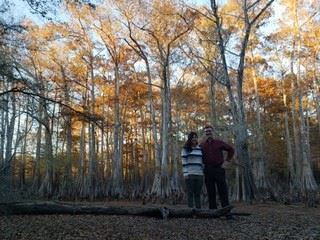 Our Mighty Bald Cypress by Ranger Andy Kilmer Hey all! The days are growing short and the leaves are changing color. Right now outside the Ranger Station I can see the rusty reds of turkey oaks, the orange-red of our native persimmons, the scarlet of virginia creeper vines, and the bright yellow of muscadine grape vines. Along the Silver River you’ll see some different shades. Aptly named red maples, burgundy sweet gum, and yellow ash trees. And towering above them all are the golden needles of the superbly beautiful bald cypress trees. You might think of evergreen spruces, pines, and firs when you think of conifers, but not all conifers look like Christmas trees and the bald cypress is a perfect example. Many conifers are adapted to extreme environments like areas with frequent fire, poor soils, or low nutrient environments. The bald cypress (Taxodium distichum) and it's stockier relative, the pond cypress, are no different: they love waterlogged environments. Found throughout the swamps and rivers of the South, our cypresses reminded European explorers of the similar looking and somewhat closely related cypresses of the genus Cupressus. The bald cypress got it's common name because they loose their needles in the winter, becoming bald! Besides its beautiful needles and boughs filled with swaying spanish moss, one of the most distinctive characteristics of bald cypress are their 'cypress knees', woody protuberances that grow up through their roots and often project out of the water in which cypresses grow. No one is really sure what advantage these knees provide the plant, but it may have something to do with anchoring or structural support in areas that are prone to frequent flooding. Old growth cypress trees were heavily logged for building material in the late 1800s and early 1900s and transported by boat or narrow gauge rail. Their slow growth and recovery kept cypress lumber production low until the 1990s when many trees recovered to a large enough size for harvest. A home movie found in Florida Memory from 1937 depicts what the last of the boom time logging of old growth cypress looked like to our north in the Big Bend region: https://www.floridamemory.com/items/show/232406 Cypress wood has great water resistance and may be used in exposed settings like outdoor structures, fence posts, river pilings, and shingles. Cypress mulch was once produced using waste wood from sawmills, but demand for cypress mulch has lead to the harvesting of young trees and the smaller pond cypress that were previously thought of as too small. These trees are important to the ecosystem and I wouldn't recommend purchasing cypress mulch for your landscaping. You may be familiar with the different colors and patterns of many softwood and hardwoods. Spalting, unique patterns and coloring caused by decay and fungi are often sought after by woodworkers. A specific form of spalting caused by the fungi Lauriliella taxodii creates large pockets in the heartwood of cypress trees which you may have heard of called 'pecky cypress'. Bald cypress swamps and cypress domes provide habitat to many species of plants and animals, with many living on or in the trees themselves. Old growth cypress stands were once home to Carolina Parakeets and Ivory-billed Woodpeckers. Like many wetland plants, the trees improve water quality and create their own flood control. Some of the best places to see cypress in our area are along the Silver, Ocklawaha, and Withlacoochee Rivers, and on the Bar and Oak Trail at Indian Lake State Forest to our north. Besides large lakes and rivers, cypress also grow in small depression swamps and form 'cypress domes' which grow higher than surrounding vegetation. A few of these domes are found on the north side of Silver Springs State Park and may be visible when driving west over the Ocklawaha bridge on State Road 40.
|



